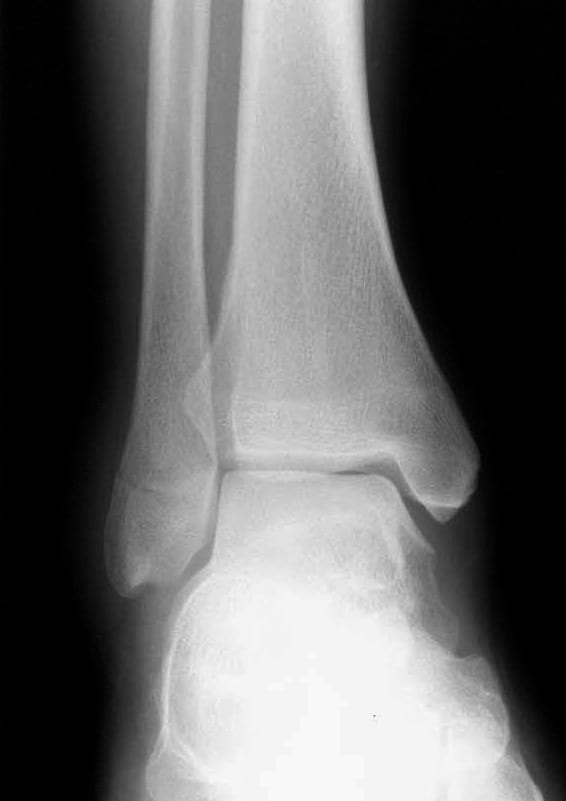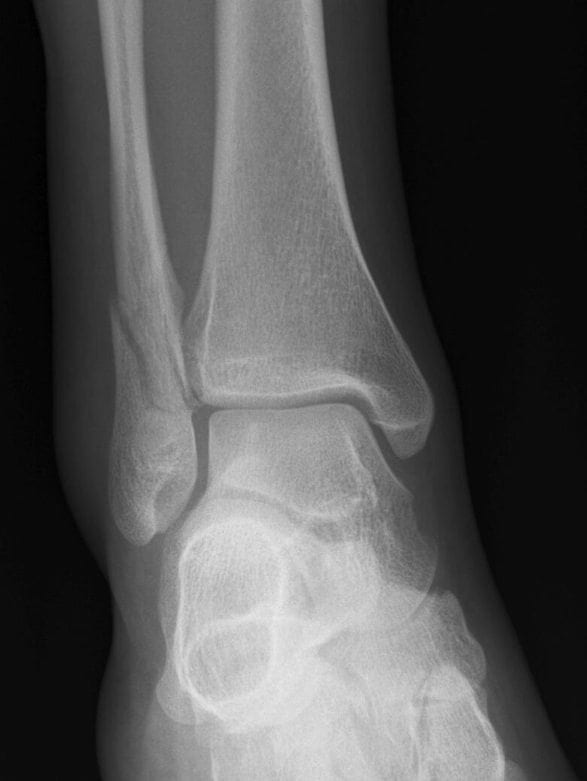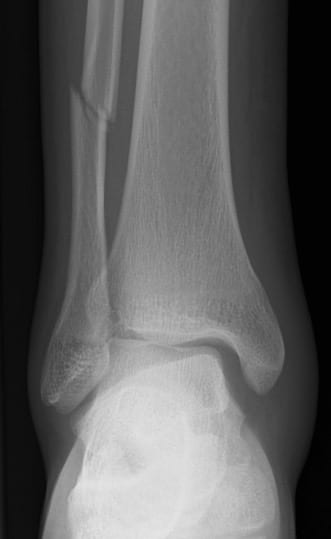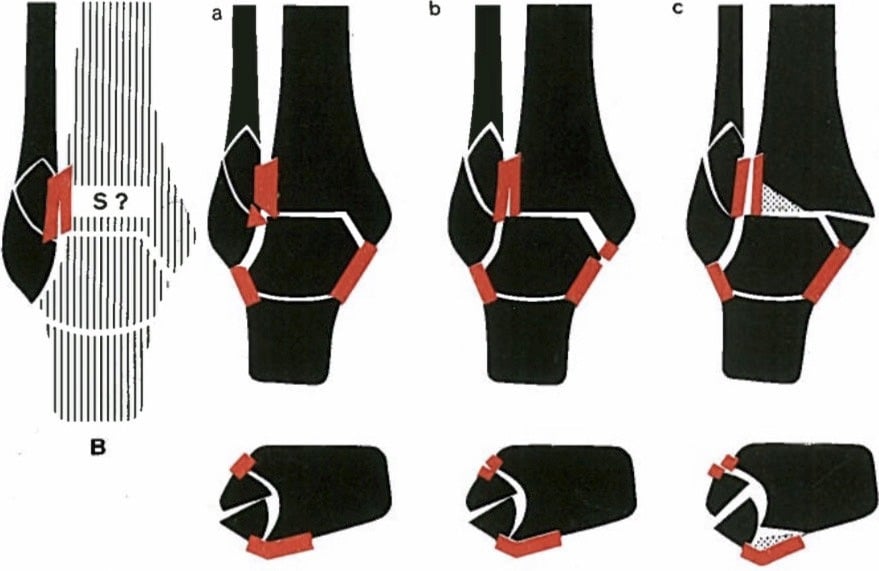Danis-Weber classification
Description
The Danis-Weber classification is a method of describing ankle fractures. It is a simple system for the classification of lateral malleolar fractures, relating to the level of the fracture in relation to the ankle joint, specifically the distal tibiofibular syndesmosis.
The classification has three primary categories, based primarily upon the fracture of the fibula, and has a role in determining treatment
- Type A. Fracture of the fibula distal to syndesmosis. An oblique medial malleolus fracture may also be present.
- Type B. Fracture of the fibula at the level of the syndesmosis. These fractures may be stable or unstable, based upon the presence of deltoid ligament rupture or medial malleolus fracture.
- Type C. Fracture of the fibula proximal to syndesmosis. These unstable fractures are generally associated with syndesmosis injuries, and may include medial malleolus fracture or deltoid ligament rupture.



History of the Danis-Weber classification
1949 – Robert Danis published ‘Théorie et pratique de l’ostéosynthèse‘ providing early basis to classification
1972 – Bernhard Georg Weber developed and popularised classification system still used in practice today
This simple ankle fracture classification system is more commonly called the Weber ankle fracture classification. It has three categories, based primarily upon the fracture of the fibula.
DANIS (1948) empfiehlt seine rein pathologisch-anatomische Klassifizierung. Danach, in etwas modifizierter Form und anderer Darstellung, unterteilen auch wir die Sprunggelenksverletzungen.
Wir stellen an die Einteilung die Anforderung, daß uns das Röntgenbild auf einen Blick über die pathologisch-anatomische Läsion bis in alle Details orientiert, wobei es uns primär nicht interessiert, wie die betreffende Verletzung zustande gekommen ist. Die Pathologie im Gebiete Fibula – Syndesmose steht dabei im Zentrum des Interesses, und wir kommen zu folgender Klassifizierung der Verletzungen des Oberen Sprunggelenkes:
A. Malleolenbrüche mit Fibulaläsion distal der Syndesmose.
B. Malleolenbrüche mit Fibulaläsion in der höhe der Syndesmose.
C. Malleolenbrüche mit Fibulaläsion proximal der Syndesmose.
Weber BG, 1972: 51 [Original text as PDF]
DANIS (1948) recommends his purely pathological-anatomical classification. Then, in a slightly modified form and a different representation, we also subdivide the ankle injuries.
For the classification we suggest that the X-ray should orientate us to the pathological-anatomical lesion at a single glance, whereby it does not interest us primarily how the respective injury came about. The pathology in the area of the Fibula – syndesmosis is the centre of interest, and we arrive at the following classification of injuries to the upper ankle joint:
A. Malleolar fractures with Fibular lesion distal to the syndesmosis
B. Malleolar fractures with Fibular lesion at the height of the syndesmosis
C. Malleolar fractures with Fibular lesion proximal to the syndesmosis
Weber BG, 1972: 51-63 [Original text as PDF]
Weber on the syndesmosis
The height of the fibular lesion is directly connected to the condition of the syndesmosis, regardless of whether there is a medial ankle injury, and of what type this may be.
Weber BG, 1972
The variants of Type A
a. Fibular band rupture
b. Avulsion fracture of the tip of the fibula
c. Transverse fracture at the height of the articulation
d. Additional transverse fracture of the medial malleolus
e. Additional chisel fracture of the medial malleolus
f. Additional fracture of the posterior edge of the tibia, oriented medio-dorsally
Coronal slices: Syndesmosis bands are always intact
Weber BG, 1972: 51-63 [Original text as PDF]
The variants of Type B
a. Isolated oblique fracture of the fibula
b. Additional rupture of the deltoid ligament
c. Additional fracture of the medial malleolus
Coronal slices: Syndesmosis bands either intact or damaged
Weber BG, 1972: 51-63 [Original text as PDF]
The variants of Type C
In all cases higher (and rarely, missing) Fibular fracture
a. Additional rupture of the deltoid ligament
b. Additional fracture of the medial malleolus
c. Additional fracture of the posterior edge of the tibia, oriented latero-dorsally
d. En-bloc sagittal fracture of the tibial tubercle
e. Maisonneuve-style subcapital fracture of the fibula
f. Apparently “clean” burst without fracture of the fibula
Coronal slices: Syndesmosis bands obligately completely insufficient
Weber BG, 1972: 51-63 [Original text as PDF]
Associated Persons
- Robert Danis (1880-1962) [Danis-Weber classification]
- Bernhard Georg Weber (1927-2002) [Weber classification]
- Niels Lauge-Hansen (1899-1976) [Lauge-Hansen classification]
Alternative names
- Weber classification
Controversies
- Danis-Weber classification system was first described by Robert Danis in 1949 and later modified and popularised by Bernhard Georg Weber in 1972, 10 years after Danis’ death.
- This simple ankle fracture classification system is more commonly called the Weber ankle fracture classification
- The Lauge-Hansen classification of rotational ankle fractures, based upon the position of the foot at time of injury, was described in 1950, 22 years prior to Weber’s description
References
Original articles
- Danis R. Les fractures malleolaires. In: Theorie et pratique de l’osteosynthese. Masson et Cie, Paris, 1949: 133-165
- Weber BG. Aktuelle probleme in der chirurgie. Band 3. Die Verletzungen des oberen Sprunggelenkes [The injuries of the upper ankle] 2e, 1972
Historical review
- Lauge-Hansen N. Fractures of the ankle. II. Combined experimental-surgical and experimental-roentgenologic investigations. Arch Surg. 1950 May;60(5):957-85.
- Hughes JL, Weber H, Willenegger H, Kuner EH. Evaluation of ankle fractures: non-operative and operative treatment. Clin Orthop Relat Res. 1979 Jan-Feb;(138):111-9
- Somford MP, Wiegerinck JI, Hoornenborg D, van den Bekerom MPJ. Ankle fracture eponyms. JBJS 2013; 95(24): e198
- Cadogan M. Eponymous Foot, ankle and talus injuries. LITFL
- Cadogan M. Danis-Weber classification. Eponym A Day. Instagram
[cite]
eponymictionary
the names behind the name
Resident medical officer in emergency medicine MB ChB (Uni. Dundee) MRCS Ed. Avid traveller, yoga teacher, polylinguist with a passion for discovering cultures.







excellent easy and straightforward explanations love your work